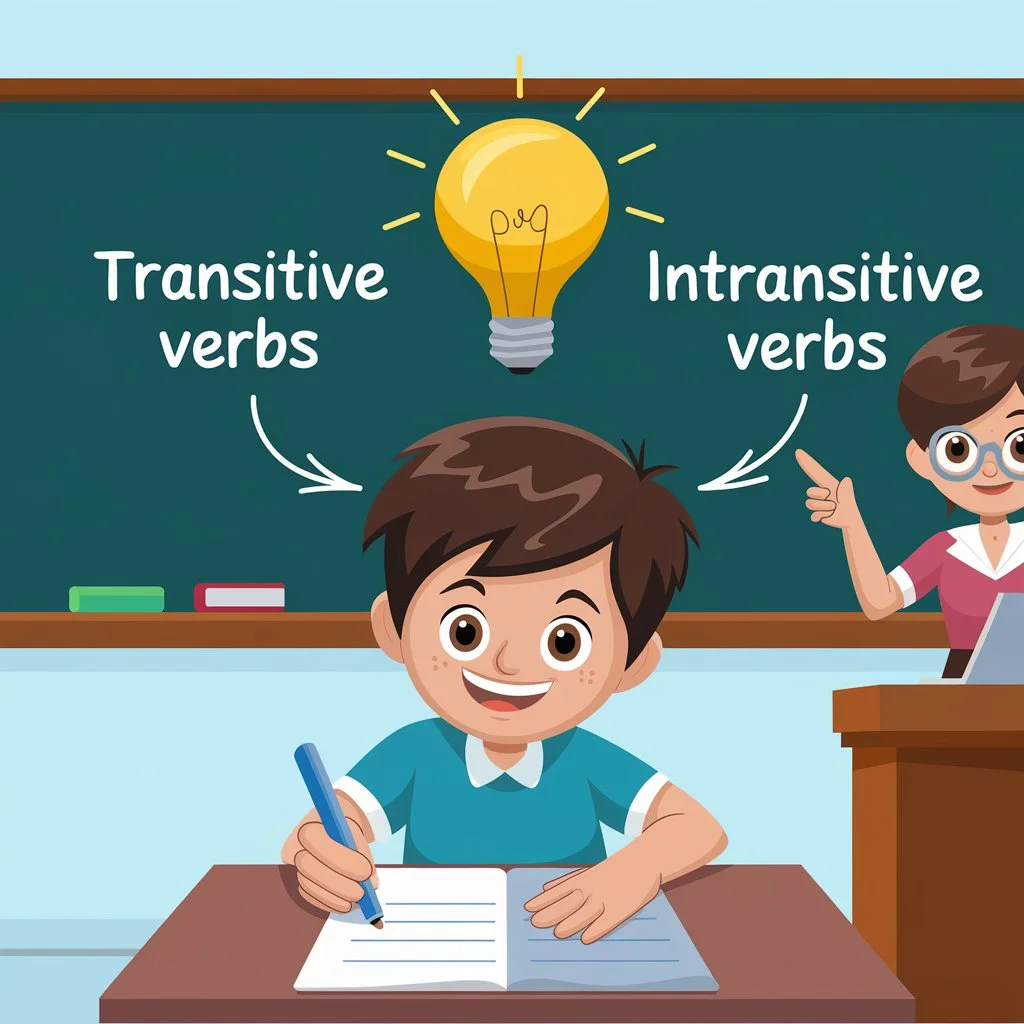Transitive verbs require a direct object to complete their meaning, while intransitive verbs do not need any object to explain them. This simple yet essential difference can significantly impact the clarity and effectiveness of your writing. Master Transitive and Intransitive Verbs with our in-depth guide! Understand the difference between these verb types, see clear examples, and learn how to use them correctly in sentences for effective communication.
Verbs are the backbone of any sentence, expressing actions, states, or events. They are divided into two main categories: transitive and intransitive verbs. Understanding the distinction between these types is crucial for constructing clear and grammatically correct sentences.
Transitive Verbs And Intransitive verbs
These verbs rely on a direct object to convey their complete meaning, as they transfer the action to someone or something. In the sentence “They built a sturdy bridge,” “built” is a transitive verb, and “a sturdy bridge” serves as the direct object. Intransitive Verbs: In contrast.
Intransitive verbs do not need a direct object to complete their meaning. They stand alone, expressing the action without transferring it to an object. In the sentence “He sleeps peacefully,” “sleeps” is an intransitive verb.
Transitive and Intransitive Verb Examples
Let’s see how transitive and intransitive verbs function in sentences. Each example sentence will have an explanation to help you grasp the concept.
- He wrote a letter.
Explanation: The transitive verb “wrote” is completed by the direct object “a letter.” Without specifying what was written, the meaning of the verb is incomplete.
- He runs every morning.
Explanation: The intransitive verb “runs” describes an action without the need for a direct object. The sentence is complete by itself, conveying the idea that he engages in the activity of running.
- She read a captivating novel.
Explanation: In this sentence, the transitive verb “read” requires a direct object, which is “a captivating novel.” The action of reading is directed towards the novel, making the sentence complete.
- Birds sing melodiously.
Explanation: The intransitive verb “sing” is complete on its own. There is no need for a direct object, and the sentence conveys that birds engage in the action of singing without specifying a particular song or recipient.
- The cat slept peacefully.
Explanation: The intransitive verb “slept” does not require a direct object. The action is self-contained, and the sentence is complete without specifying what the cat slept on or with.
- He painted a vibrant mural.
Explanation: The transitive verb “painted” is fulfilled by the direct object “a vibrant mural.” Without specifying what was painted, the meaning of the verb is incomplete.
How to Identify ?
Identifying transitive and intransitive verbs can be simplified by understanding their characteristics. We know that a transitive verb needs a direct object to complete its meaning, while an intransitive verb does not. To identify transitive verbs, ask the questions “What?” or “Whom?” after the verb. If there is a clear answer, such as in the sentence “He reads a book,” the verb “reads” is transitive because it answers the question “reads what?” with the direct object “a book.”
On the other hand, intransitive verbs do not need a direct object to convey their meaning. When asking “What?” or “Whom?” after a verb, if there is no meaningful answer, it is likely an intransitive verb. For example, in the sentence “She sleeps peacefully,” the verb “sleeps” is intransitive, and there is no direct object because the action of sleeping is complete with just the subject. Understanding this distinction is essential in constructing grammatically correct sentences and conveying the intended message.
Verbs that are both Transitive and Intransitive
While many verbs neatly fall into either the transitive or intransitive group, some verbs can be both transitive and intransitive, depending on how they are used. The key difference lies in whether or not the verb is accompanied by a direct object. Here are some examples:
- To eat: Transitive: She eats an apple. (The direct object is “an apple.”)
- Intransitive: He eats his lunch. (There is no direct object.)
- To run: Transitive: She runs a marathon. (The direct object is “a marathon.”)
- Intransitive: He runs in the park. (There is no direct object.)
- To open: Transitive: She opens the door. (The direct object is “the door.”)
- Intransitive: The door opens slowly. (There is no direct object.)
- To close: Transitive: He closes the book. (The direct object is “the book.”)
- Intransitive: The book closes with a thud. (There is no direct object.)
- To break: Transitive: She breaks the vase. (The direct object is “the vase.”)
- Intransitive: The vase breaks into pieces. (There is no direct object.)
In each of these examples, the meaning of the verb changes slightly depending on whether it is used as a transitive or intransitive verb. By understanding the difference between transitive and intransitive verbs, you can use these verbs more effectively and construct grammatically correct sentences.
Passive Voice Version
While passive voice is a grammatical construction that is often associated with transitive verbs, it is not a common practice to use passive voice with intransitive verbs due to the lack of a direct object. Passive constructions are more straightforward and natural with transitive verbs where there is a clear action being performed on an object.
Transitive Verbs and Passive Voice
When transitive verbs are used in the passive voice, the direct object becomes the subject of the sentence.
Example:
Active Voice: The chef prepares the dish. Passive Voice: The dish is prepared by the chef. In the passive construction, “eats” (transitive verb) becomes “is eaten” to shift the focus from the doer of the action (“She”) to the receiver of the action (“The cake”).
Intransitive Verbs and Passive Voice
In standard usage, sentences with intransitive verbs are not typically transformed into passive voice constructions because there is no direct object to become the subject.
Example:
Active Voice: They protested peacefully. There is no direct object in this sentence for the verb “protested,” making it challenging to construct a passive voice equivalent. Here, the verb “protested” is an intransitive verb, and “peacefully” is an adverb describing how the protest occurred, not functioning as a direct object.
The Role of Phrasal Verbs in Transitivity
Phrasal verbs, formed by combining a main verb with one or more particles (prepositions or adverbs), can significantly influence whether a verb is transitive or intransitive. The behavior of phrasal verbs in this context is a fascinating aspect of English grammar. If the phrasal verb requires a direct object to convey a complete meaning, it is likely transitive. If the phrasal verb stands alone, expressing a complete action or state without requiring a direct object, it is likely intransitive.
Phrasal Verbs as Transitive
Many phrasal verbs function as transitive verbs, requiring a direct object to complete their meaning. The addition of a particle often changes the verb’s original meaning, transforming it into a new expression.
Example:
Original Verb: She looked at the painting. Phrasal Verb: She looked up the information. In the phrasal verb “look up,” the addition of “up” changes the verb’s transitivity, now requiring a direct object (“the information”) to convey a complete thought.
Phrasal Verbs as Intransitive
Conversely, certain phrasal verbs operate intransitively, standing alone without the need for a direct object. These verbs often convey a complete action or state without requiring additional elements.
Example:
Original Verb: He turned on the light. Phrasal Verb: The situation turned around. In the phrasal verb “turn around,” the verb becomes intransitive, describing a change in a situation without the necessity of a direct object.
Difference
Here’s a tabular representation of the difference between transitive and intransitive verbs:
| Criteria | Transitive Verbs | Intransitive Verbs |
|---|---|---|
| Definition | Verbs that require a direct object to complete their meaning. | Verbs that do not need a direct object to complete their meaning. |
| Object Requirement | Requires a direct object. | Does not require a direct object. |
| Examples | She read a book. (read is transitive) | He runs quickly. (runs is intransitive) |
| Passive Voice Usage | Can be used in passive voice. | Typically not used in passive voice. |
| Role of Phrasal Verbs | Phrasal verbs can be transitive. | Phrasal verbs can be intransitive. |
FAQs
What is the difference between transitive and intransitive verbs?
Transitive verbs require a direct object to complete their meaning, while intransitive verbs do not need a direct object and can stand alone in a sentence.
Can a verb be both transitive and intransitive?
Yes, some verbs can be both transitive and intransitive, depending on how they are used in a sentence. The key difference is whether they have a direct object.
How can I identify a transitive verb?
To identify a transitive verb, ask the questions “What?” or “Whom?” after the verb. If there is a clear answer (like a direct object), then the verb is transitive.
Do intransitive verbs work with passive voice?
No, intransitive verbs are typically not used in the passive voice because they do not have a direct object to become the subject of the sentence.
What role do phrasal verbs play in transitivity?
Phrasal verbs can be either transitive or intransitive. If they require a direct object, they are transitive; if they do not, they are intransitive.
What is a direct object in relation to transitive verbs?
A direct object is the noun or pronoun that receives the action of a transitive verb. For example, in the sentence “She read a book,” “book” is the direct object of the verb “read.”
Can all verbs be categorized as either transitive or intransitive?
Most verbs can be categorized as either transitive or intransitive, but some verbs can function as both, depending on the context in which they are used.
Why is it important to understand transitive and intransitive verbs?
Understanding transitive and intransitive verbs helps in constructing grammatically correct sentences and ensures that the intended meaning is accurately conveyed.
How does the use of passive voice differ between transitive and intransitive verbs?
Passive voice is commonly used with transitive verbs because they have a direct object that can become the subject of the sentence. Intransitive verbs usually do not work in the passive voice because they lack a direct object.
Can intransitive verbs have an adverb instead of a direct object?
Yes, intransitive verbs often use adverbs to modify or describe the action, but these adverbs do not serve as direct objects. For example, in the sentence “He runs quickly,” “quickly” is an adverb, not a direct object.
Conclusion
Understanding the difference between transitive and intransitive verbs is crucial for constructing grammatically correct and meaningful sentences in English. Whether you are a student, a professional, or simply someone interested in mastering the language, grasping the concept of verb transitivity will enhance your writing and communication skills. Remember, transitive verbs require a direct object to complete their meaning, while intransitive verbs stand alone, expressing actions or states without transferring them to an object. By practicing with examples and paying attention to the context in which verbs are used, you can confidently navigate the complexities of English grammar.

I’m Mira Sinclair, the expert helping you navigate grammar sections at “Grammer Grove.” Playing with words and expressions is my thing. At Grammer Grove, we’re here to make yourwriting stand out and shine. Let’s make your appreciation heartfelt and memorable—come and join the fun at Grammer Grove!












